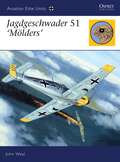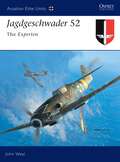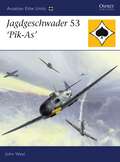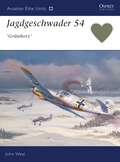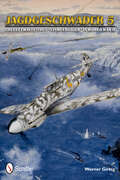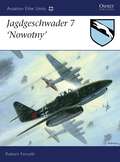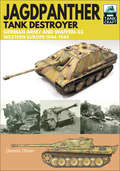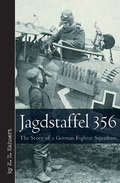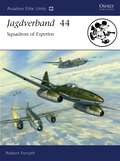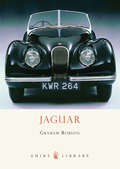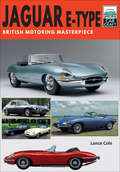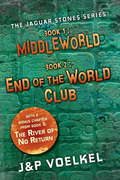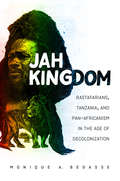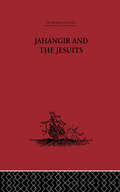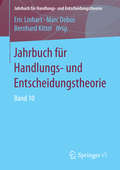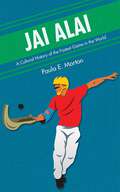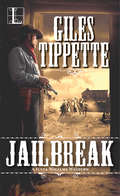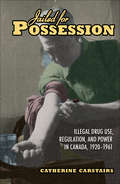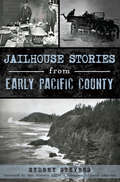- Table View
- List View
Jagdgeschwader 51 'Mölders'
by John WealJG 51 were one of the Luftwaffe’s top wartime fighter units, yet their story has never been told in English. The unit’s history encapsulates the fortunes of the Luftwaffe’s fighter arm as a whole - the heady successes of the early months, the steady attrition and the growing strength of the opposition during the mid-war years, and the final chaos and collapse of the last days. But it is perhaps the details of the pilots who served with the unit that sets JG 51 apart. During the course of the war it numbered more Knight’s Cross winners among its ranks than any other. And it is their stories – their successes, exploits and eventual fates – which brings this history to life.
Jagdgeschwader 52: The Experten
by John WealJagdgeschwader 52 (JG 52) was the most successful and highest-scoring fighter unit, not just in Germany’s World War 2 Luftwaffe, but in the entire annals of aviation history. No other fighter group has ever come close to matching its staggering total of around 9000 enemy aircraft shot down in combat. And yet, because much of that combat took place over the tractless wastes of the Russian front, very little has been written in English about the exploits of this charismatic unit. This book provides a full combat history of JG 52 and its members, including the three top-scoring aces of all time, who claimed a total of 900 victories between them.
Jagdgeschwader 53 'Pik-As'
by John WealArguably the archetypal Luftwaffe fighter unit of World War 2, JG 53 aircraft were encountered on almost every fighting front from the first day of hostilities until the last. During almost six years of near-constant campaigning, JG 53 took a steady toll of Allied aircraft in every theatre it fought over. The variety of camouflage finishes worn by its machines -winter white, desert dapple and Reich's defence black - and the progression of variants are reflected in an eye-opening colour section. John Weal has spent several years researching in German archives and this, together with his personal contact with several veterans, results in an authoritative and human account of JG 53's long and eventful war.
Jagdgeschwader 54: 'Grünherz'
by John WealOne of the most successful of the high-scoring Luftwaffe Jagdgeschwader during World War 2, JG 54 ‘Grünherz’ (Green Hearts) was formed from three disparate fighter 'Gruppen' immediately prior to the Battle of Britain. Having enjoyed immediate success over the Channel and South-east England during the summer of 1940, the unit was transferred to the Eastern Front in the spring of 1941 in preparation for Operation Barbarossa - the German invasion of the Soviet Union. JG 54 would remain a Jagdwaffe stalwart in the east, flying firstly Bf 109Fs and then the Fw 190. By war’s end, the Geschwader’s pilots had claimed over 9500 kills, and produced over 100 aces. Men like Hans Philipp, Walter Nowotny and Otto Kittel are profiled in this volume, which reveals the struggle in the face of overwhelming odds that was the lot of the Jagdflieger on the Eastern Front.
Jagdgeschwader 5: The Luftwaffe’s JG 5 “Eismeerjäger” in World War II
by Werner GirbigFirst English language edition of the definitive JG 5 history
Jagdgeschwader 7 Nowotny
by Jim Laurier Robert ForsythWhen the revolutionary Messerschmitt Me 262 jet fighter first appeared in the skies over northwest Europe in mid-1944, it represented one of the greatest challenges to Allied air superiority. The first group to solely fly jet fighters, Jagdgeschwader 7 was tasked with wrestling back command of the skies. Put almost immediately into action, despite fuel shortages, poor training and problems with the jet engine, victories quickly followed against both US and British aircraft. By the end of the war, the Jagdgeschwader had claimed nearly 200 enemy aircraft destroyed in daylight bomber raids during 1945. This book follows the history of the JG 7 unit, examining how their courage, determination and the most advanced aircraft in the world were simply not enough to ensure victory. In the final section of the book Robert Forsyth details how JG 7 were eventually defeated by gradual losses, restricted operating conditions, lack of fuel and overwhelming Allied fighter strength.
Jagdpanther Tank Destroyer: German Army and Waffen-SS, Western Europe, 1944–1945 (TankCraft)
by Dennis Oliver&“First class illustration and a very effective text overview . . . covers the development, on the Panther chassis, of a very effective tank destroyer.&”— Firetrench Combining the destructive firepower of the 88mm gun with the outstanding mobility of the Panther series, the Jagdpanther is quite probably the best-known tank destroyer of the Second World War. In the vehicle&’s first action on 30 July 1944, three Jagdpanthers managed to destroy eleven British tanks in a vicious two-minute fire fight near the village of Les Loges in Normandy, cementing the Jagdpanther&’s reputation as a potent tank killer. In his fifth book in the TankCraft series, Dennis Oliver uses contemporary photographs and meticulously researched, superbly presented color and monochrome illustrations to tell the story of these heavy self-propelled antitank guns and the units which operated them in the German defense of the Western Front. As with all the books in the TankCraft series, a large part of this work showcases available model kits and aftermarket products, complemented by a gallery of expertly constructed and painted models. Technical details as well as modifications introduced during production and in the field are also explained giving the modeler all the information and knowledge required. &“Really interesting concept to combine historical, technical and modeling content in one book. Nicely illustrated . . . As a first Jagdpanther book for modelers seeking an economical source on models, accessories and paint schemes, this is valuable… Highly Recommended for Beginner to Intermediate builders.&”—AMPS
Jagdpanther vs SU-100
by David Higgins Richard ChasemoreThe culmination of big-gun German and Soviet tank destroyer design can be found in their clashes in Hungary in the spring of 1945. As World War II in Europe reached its end, armor development and doctrine had experienced several years of massively accelerated change, especially within the crucible of the Eastern Front. The German Jagdpanther and Soviet SU-100, both turretless tank destroyer designs based on a 'traditional' turret-tank chassis, were the culminating examples of how the progression of experience, resources and time constraints produced vehicles that were well suited for roles of defence and offence, respectively. The Jagdpanther represented a well-balanced solution and an excellent use of limited resources, while the SU-100 was a natural progression of the rudimentary but numerous SU-85.As the role of tanks broadened from essentially infantry support to anti-tank, armor thickness and armament increased to enable AFVs better to survive such encounters. Expensive and hard to upgrade with larger armament owing to the constraints imposed by turret-ring size and suspension, turreted tanks gave way in some contexts to new designs. The Soviets and the Germans alike found that more powerful guns could be installed directly into the hull, which in turn reduced the vehicle's silhouette, and allowed for increased armour protection for the weight. A rapid arms race resulted in the East with each side attempting to develop a battlefield edge, if only for a limited time.For the Germans the 8.8cm-armed Jagdpanther was intended for more defensive roles, such as ambushing or flank protection at long range where its superior sights and high-velocity rounds imparted an advantage. Its sloped armor and relatively light weight meant, unlike the more massive (and less practical) Jagdtiger (a Tiger II derivative), it could also operate in a more mobile capacity. Its superior optics offered key firepower advantages, but its origins in the overengineered Panther design meant it was susceptible to breakdown and mechanical problems.In contrast, the closest Soviet equivalent, the SU-100, was designed to operate alongside armor and mechanized forces in an offensive capacity, where its 100mm main gun would help counter heavier enemy armour when encountered. Although its speed and armour protection were comparable, the greater numbers fielded late in the war often proved decisive against an adversary increasingly forced to fight despite inadequate logistics and training. By this stage of the conflict, the Germans were forced to adopt ad hoc battle groups to coordinate their decimated parent formations' assets. The Soviets in turn possessed operational momentum, and were perhaps less concerned with tactical losses, in part as immobilized vehicles could be more easily recovered and reintroduced into combat.
Jagdstaffel 356: The Story of a German Fighter Squadron (Vintage Aviation Library)
by M.E. KaehnertA visceral and accurate firsthand account of flying with the Imperial German Air Force during WWI. The airborne fighting squadrons of the Imperial German Luftstreitkräfte—known as the Jagdstaffel or Jasta—were a fearsome and elite force throughout the Great War. Though the entire force was dissolved and their aircraft destroyed by order of the Treaty of Versailles, the stories of the pilotremain in books like Jagdstaffel 356. Although the author has given this Jagdstaffel a fictitious number and changed the names of the pilots composing it, the vivid descriptions and accurate narrative have the genuine ring of truth. Anyone who has had experience of flying on the Western Front or who has studied it since will recognize this chronicle as factual. Many experts believe this work draws on the experience of the Bavarian Jasta 35, which flew against the British; however, whatever its real number may have been, the squadron depicted in Jagdstaffel 356 undoubtedly fought in the air over Flanders in 1918.
Jagdverband 44
by Jim Laurier Robert ForsythJagdverband 44 was formed in February 1945 on Hitler's orders, to fly the Me 262 "Stormbird", the world's first operational jet fighter, and demonstrate its superiority. The unit was led by the legendary Adolf Galland, who recruited some of Germany's leading aces into it, to the extent that it was said that the Knight's Cross was its unofficial badge. JV 44 engaged the US Ninth Army Air Force over Bavaria and, with its significant speed advantage and powerful armament of cannon and rockets, the Me 262 proved a formidable interceptor in the hands of its expert pilots. In its brief operational existence, never able to get more than six jets in the air at any one time, this small unit achieved approximately 50 kills in less than a month. Unfortunately for the German defensive effort (though Galland himself was glad not to have prolonged the war) there were not enough Me 262s to have any overall effect on the Allied air campaign.This book is a dramatic record of a highly individual unit and an exciting early chapter in the history of the jet fighter. Four of the world's ten surviving Me 262s are major attractions at flight museums in the USA and recently constructed replicas will soon be a feature of air shows around the nation and the "experten" aces of the Luftwaffe have an enduring fascination.From the Trade Paperback edition.
Jaguar
by Graham RobsonSir William Lyons enjoyed a seemingly unstoppable rise to fame and fortune in the motor industry, and the Jaguar brand which he introduced became world-famous. Yet it did not happen overnight. In the 1920s he was in Blackpool, styling motorcycle sidecars, in the 1930s he was in Coventry developing the SS motor car, and the stand-alone Jaguar company did not appear until 1945. Until 1972, when he retired from business, Sir William was the mainstream, the chairman, the chief stylist, and the inspiration of all things Jaguar.Helped along by the amazing new XK engine of 1948, by motor racing success at Le Mans, and by the stunning style of cars like the XK120, the Mk 2 saloons and the extraordinary E-Type, Jaguar soon became world-famous. Along the way the company absorbed Daimler and Coventry-Climax, then merged voluntarily with BMC in 1966, and returned to Le Mans racing with great success in the 1980s.Although the company was later commercially buffeted by its involvement with British Leyland, with Ford and latterly with Land Rover, and finally the Indian conglomerate Tata which now controls the business, the company's products have always been stunning. Sports coupes which reach well beyond 150mph, sleek executive saloons with unbeatable styling, and the promise of much innovation in the next few years make this a story whose climax is yet to come.
Jaguar E-Type: British Motoring Masterpiece (Car Craft)
by Lance ColeThe author of Classic Car Gallery &“covers the Jaguar and its various incarnations with lovingly snappy prose . . . to excite the passions of Jaguar-mania&” (The Historical Miniatures Gaming Society). The third book in the new CarCraft series, Jaguar E-Type, frames the legend of what many call the world&’s most beautiful car design. Sir William Lyons and Malcolm Sayer carved automotive history with this car across its 1960s-1970s incarnations from roadster to coupé amid the fitting of Straight-Six, to V12 engines. With its new definition of sculptural styling, performance, handling and innovative style, the E-Type or XKE series in the USA, created a car of global impact that remains a great classic of all time. Here, experienced automotive writer, and industrial designer, Lance Cole pays tribute to the car in a detailed yet engaging commentary. New photography, the design story, and full coverage of the modeling options in synthetic materials and die cast metals, create a narrative of vital interest.The aim of the innovative CarCraft series is to provide modelmakers and car enthusiasts with a new standard of primarily visual reference of both full-size cars and their scale models. Each book contains detailed technical information imparted through drawings and photographs while the meticulously researched full-color profiles provides a complete reference for paint schemes and markings. In addition, every volume of the CarCraft series features summaries of design histories and operational careers, and reviews of available kits. &“This book will be of great interest to modelers planning on doing a Jaguar model and also to car enthusiasts.&”—AMPS Indianapolis
Jaguar Night
by Doranna DurginImagine a world where a sleek, dark jaguar wanders after twilight, seeking his mate, offering her protection from harm and the most sensual nights her heart could ever desire.... At dusk he prowled the Southwest, a huge, sleek black jaguar with startling blue eyes and a man's thoughts. A shape-shifting Sentinel, Dolan Treviño projected an intensely animalistic aura that hid the scars of his past. Yet as fierce as his pride was, this immensely powerful guardian needed the intuition and spirit of an innocent horse trainer to find redemption. The moment he set foot on her ranch, Meghan Lawrence rejected the shape-shifter's protection--but she couldn't turn her back on her family legacy. Her mother had died protecting a magical manuscript that the Sentinels' dark counterparts would now do anything to recover. With an unbreakable will and all-consuming passion, only Dolan possessed the strength to save Meghan. But was she strong enough to tame the beast within? A Jaguar shifter romance. Previously published.
Jaguar Stones 2 for 1
by Jon Voelkel Pamela VoelkelFor fans of Percy Jackson, the first two thrilling adventure books in the Jaguar Stones series, set in the heart of the Maya underworld. Get ready for the ride of your life as pizza-loving American teen Max and his Maya friend Lola try to stop the Lords of Death from bringing destruction to Xibalba, or as we know it, planet Earth. Includes a bonus chapter from book 3 in the Jaguar Stones series.
Jah Kingdom: Rastafarians, Tanzania, and Pan-Africanism in the Age of Decolonization
by Monique A. BedasseFrom its beginnings in 1930s Jamaica, the Rastafarian movement has become a global presence. While the existing studies of the Rastafarian movement have primarily focused on its cultural expression through reggae music, art, and iconography, Monique A. Bedasse argues that repatriation to Africa represents the most important vehicle of Rastafari's international growth. Shifting the scholarship on repatriation from Ethiopia to Tanzania, Bedasse foregrounds Rastafari's enduring connection to black radical politics and establishes Tanzania as a critical site to explore gender, religion, race, citizenship, socialism, and nation. Beyond her engagement with how the Rastafarian idea of Africa translated into a lived reality, she demonstrates how Tanzanian state and nonstate actors not only validated the Rastafarian idea of diaspora but were also crucial to defining the parameters of Pan-Africanism. Based on previously undiscovered oral and written sources from Tanzania, Jamaica, England, the United States, and Trinidad, Bedasse uncovers a vast and varied transnational network--including Julius Nyerere, Michael Manley, and C. L. R James--revealing Rastafari's entrenchment in the making of Pan-Africanism in the postindependence period.
Jahangir and the Jesuits: With an Account of the Benedict Goes and the Mission to Pegu
by From the GuerreiroFirst published in 1930. 'The book is full of splendour and strange scenes' NationThe Relations of Fernão Guerreiro, from which the three narratives in this volume have been taken, constitute a complete history of the missionary undertakings of the Society of Jesus in the East Indies, China, Japan and Africa during the first decade of the seventeenth century. The work was compiled from the annual letters and reports sent to Europe from the various missionary centres. The original work, which until this edition was published in 1930, had never been reprinted. The only complete copy exists in the British Museum Library, in London.
Jahrbuch für Handlungs- und Entscheidungstheorie
by Marc Debus Eric Linhart Bernhard KittelHandlungs- und Entscheidungstheorien gelten als erfolgversprechende Ansätze zur Erklärung sozialen Handelns. Handeln wird dabei als das Ergebnis eines Prozesses gesehen, bei dem Akteure aus verschiedenen verfügbaren Handlungsalternativen diejenige auswählen, die bei gegebenen Rahmenbedingungen und erwarteten Handlungen anderer Akteure ihre Ziele am besten zu verwirklichen verspricht. Band 10 des Jahrbuchs vereint innovative Beiträge zur Handlungs- und Entscheidungstheorie, die sich mit der gesamten Breite des Feldes befassen. Die Themen reichen von Arbeiten, die Reaktionen in unterschiedlichen marktwirtschaftlichen Systemen auf die Finanzkrise analysieren, über Aufsätze, die aus spieltheoretischer Sicht Probleme bei der Etablierung des Sozialstaats in lateinamerikanischen Ländern aufzeigen, bis hin zu Beiträgen, die sich mit der Reaktion von Wählern auf Koalitionssignale befassen. Auch methodisch decken die Beiträge des vorliegenden Bandes eine große Bandbreite ab. So werden wichtige Konzepte kollektiven Entscheidens sowohl theoretisch verfeinert als auch experimentell oder mit Hilfe von Simulationen überprüft.
Jahrbuch für Handlungs- und Entscheidungstheorie: Band 12 (Jahrbuch für Handlungs- und Entscheidungstheorie)
by Marc Debus Markus Tepe Jan SauermannHandlungs- und Entscheidungstheorien gelten als erfolgversprechende Ansätze zur Erklärung sozialen und politischen Handelns. Handeln wird dabei als das Ergebnis eines Prozesses gesehen, bei dem Akteure aus verschiedenen verfügbaren Handlungsalternativen diejenige auswählen, die bei gegebenen Rahmenbedingungen und erwarteten Handlungen anderer Akteure ihre Ziele am besten zu verwirklichen verspricht. Band 12 des Jahrbuchs vereint innovative Beiträge zur Handlungs- und Entscheidungstheorie, die sich mit der gesamten Breite des Feldes befassen.
Jai Alai: A Cultural History of the Fastest Game in the World
by Paula E. MortonPaula Morton provides a fun, concise introduction to jai alai, a fast-paced ball game with ancient roots that is admired by fans for the sport&’s power and spectacle. Cesta punta, as the game is known in its Basque homeland, became a phenomenon during the twentieth century as organized jai alai spread from Spain into the Caribbean, Latin America, the United States, and Asia. This book outlines the multifaceted history of the sport, from its beginnings in Basque country to its North American &“unveiling&” at the 1904 Louisiana Purchase Centennial Exposition and World&’s Fair and to its rise and fall in popularity in the United States. Guest essays and historic photographs offer extensive insight into the sport&’s fascinating history. Morton further explores the players and venues, providing a carefully crafted and thoroughly researched look into jai alai. Sports lovers and cultural history enthusiasts will marvel at the sport&’s unique history and reach.
Jail Blazers: How the Portland Trail Blazers Became the Bad Boys of Basketball
by Kerry EggersIn the late ’90s and early 2000s, the Portland Trail Blazers were one of the hottest teams in the NBA. For almost a decade, they won 60 percent of their games while making it to the Western Conference Finals twice. However, what happened off-court was just as unforgettable as what they did on the court. When someone asked Blazers general manager Bob Whitsitt about his team’s chemistry, he replied that he’d “never studied chemistry in college.” And with that, the “Jail Blazers” were born. Built in a similar fashion to a fantasy team, the team had skills, but their issues ended up being their undoing. In fact, many consider it the darkest period in franchise history. While fans across the country were watching the skills of Damon Stoudamire, Rasheed Wallace, and Zach Randolph, those in Portland couldn’t have been more disappointed in the players’ off-court actions. This, many have mentioned, included a very racial element—which carried over to the players as well. As forward Rasheed Wallace said, “We’re not really going to worry about what the hell [the fans] think about us. They really don’t matter to us. They can boo us every day, but they’re still going to ask for our autographs if they see us on the street. That’s why they’re fans and we’re NBA players.” While people think of the Detroit Pistons of the eighties as the elite “Bad Boys,” the “Jail Blazers” were actually bad. Author Kerry Eggers, who covered the Trail Blazers during this controversial era, goes back to share the stories from the players, coaches, management, and those in Portland when the players were in the headlines as much for their play as for their legal issues.
Jailbreak (A Justa Williams Western #2)
by Giles TippetteAcclaimed western writer Giles Tippette takes the action south of the border, where blood is thicker than water no matter how many bullets are fired . . . Running the Half-Moon ranch is all the excitement Justa Williams needs in his life. But when his brother Norris looks into a squatter situation near the Mexican border and lands in a Monterrey jail for his troubles, Justa rides out to get his kin released. When the usual channels get rebuffed, Justa enlists the aid of a dozen kill-crazy banditos to get the matter resolved the old-fashioned way. Now there's just a hundred miles of Mexican desert to cross before they can reach the Texas border. Hopefully they've got enough bullets left to get them there . . . Praise for Giles Tippette and The Bank Robbers "Tippette can plot away with the best of them." --Dallas Morning News "Like True Grit . . . a small masterpiece . . . brilliantly written." --Newark News "Spine-jarring, bullet-biting intensity." --Houston Post "Tough, gutsy, and fascinating." --NY Newsday "Impressive authenticity." --Booklist "His fiction is taught and gripping." --Houston Spectator
Jailed for Freedom: A First-Person Account of the Militant Fight for Women's Rights
by Doris StevensThe 100th-anniversary special edition of Jailed for Freedom, the essential history and first-person account of the courageous and militant suffragists who fought for their right to vote. First published in 1920, Jailed for Freedom is the courageous, true story of the militant suffragists who organized some of the first-ever, large scale demonstrations and protests on Washington. At a time when President Woodrow Wilson's administration refused to acknowledge women's voting rights as a tangible issue, the National Woman's Party coalesced, organized, and fought a fierce battle for the ratification of the Nineteenth Amendment with heroism, bravery, and radical vigilance. What makes Jailed for Freedom especially compelling and such an important contribution to women's history is that it is a personal testimony from a suffragist who persevered through it. With depth and clarity, Doris Stevens details the bravery of the women who picketed daily outside the White House, opened themselves up to ridicule and physical violence, were arrested on no viable charges, jailed when they chose not to pay fines, and even beaten and force-fed when they went on hunger strikes. Including a new introduction from suffrage historian Angela P. Dodson, author of Remember the Ladies, and accompanied with poignant, archival illustrations, Jailed for Freedom is a tribute to the women and acts it took the pass the Nineteenth Amendment, apropos of radical activism that is still mobilizing in politics today.
Jailed for Possession
by Catherine CarstairsAs rates of illegal drug use increase, the debates over drug policy heat up. While some believe penalties should be harsher, others advocate complete decriminalisation. Certainly, debate over the 'war on drugs' is not new. In the early 1920s, as the drive for Chinese Exclusion gathered steam, Canadians blamed the Chinese for the growing use of opium and other drugs, and parliamentarians passed extremely harsh drug laws to counter this use. These laws remained in place until the 1960s.In Jailed for Possession, Catherine Carstairs examines the impact of these drug laws on users' health, work lives, and relationships. In the middle of the century, drug users regularly went to jail for up to two years for possession of even the smallest amount of opium, morphine, heroin, or cocaine, often spending more time incarcerated than on the street. As enforcement increased and drugs became harder to obtain, drug use became an increasingly central preoccupation, making it almost impossible for users to hold down steady jobs, support families, or maintain solid relationships.Jailed for Possession is the first social history of drug use in Canada and provides a careful examination of drug users and their regulators including doctors, social workers, and police officers.
Jailhouse Stories from Early Pacific County (True Crime)
by Sydney Stevens Matt WintersHangings, lynchings and jail breaks are long forgotten in Pacific County, where tourists flock to quaint attractions every season. But back in the early days, when the first jailhouse was built, this was a rough, rustic setting. Popular cannery worker Lum You was hanged here in 1902--the only legal execution in county history. Industrious smugglers and creative entrepreneurs outwitted state-sanctioned prohibition measures, though some still did time in the jailhouse. Historian Sydney Stevens presents a collection of tales culled from a forgotten prison record book. Opium fiends, thieves, military deserters and even wayward girls jailed for incorrigible acts are brought out of the shadows of a wilderness long gone.
Jailing the Johnstown Judge: Joe O'Kicki, the Mob and Corrupt Justice (True Crime)
by Bruce J. SiwyIn 1988, Judge Joe O'Kicki was regarded by his peers as one of the most brilliant legal minds in the United States. He was newly re-married, sworn in as the president judge of a Pennsylvania county and on the fast track to a federal bench.... Silently, however, a state police vice unit was in the midst of covert operation into O'Kicki's personal affairs. The judge would be accused of soliciting bribes, frequenting brothels and running the county as if he were a "battleship commander." Later he'd concoct a plan to flee the country and exact revenge on his enemies. Set in the aftermath of the 1977 Johnstown flood and including courtroom testimony, the memos of whistleblowers, contemporary interviews and excerpts from O'Kicki's unfinished tell-all memoir, "Jailing the Johnstown Judge" is a fresh examination of the extraordinary Western Pennsylvania case that attained international infamy.
